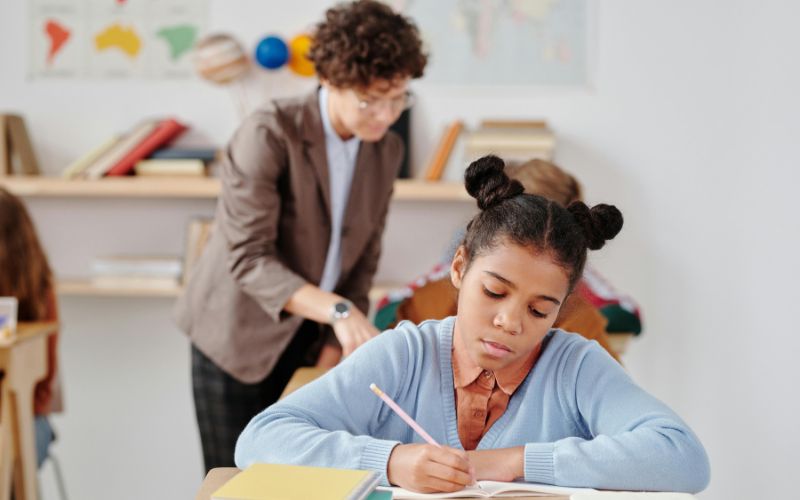
Developing leadership in students is crucial for their academic and social success. This article discusses practical strategies and approaches to prepare students and help them build leadership skills, enhancing their confidence and ability to lead in various settings.
Key Takeaways
- Leadership skills are essential for students, contributing to personal growth, career advancement, and effective collaboration.
- Core leadership skills include communication, critical thinking, and self-awareness, which are vital for influencing others and navigating challenges.
- Creating opportunities for leadership through extracurricular activities, group projects, and community service is crucial for practicing and enhancing leadership abilities.
- Obtaining a leadership position is significant for personal and professional development. Such roles enhance soft skills like communication and adaptability, help individuals differentiate themselves in competitive environments, and allow them to explore their strengths and interests more deeply.
Why Leadership Skills Matter for Students
Leadership skills are the bedrock of personal and professional growth. For students, these skills are not just about taking charge but about becoming self-advocates and taking initiative in their own lives. Student leadership contributes to developing independence, which is crucial in both social and academic contexts. Imagine a student who can confidently navigate group projects, take on leadership roles, and inspire peers—all while managing their own responsibilities effectively. This is the power of leadership skills.
But why do these skills matter so much? For one, they are essential for pushing careers forward. By focusing on developing leadership skills now, students prepare themselves for future leadership roles in their careers. Good leaders exhibit natural traits and benefit from honing their abilities, fostering collaboration among team members, and being effective communicators and listeners. Leadership skills help students gain confidence, effective work habits, collaboration abilities, and ultimately, career success. This is not just about holding a title or a position; it’s about setting an example and positively influencing peers. Developing leadership skills adds value to a student’s profile, improving their leadership effectiveness and making them more attractive to future employers.
Moreover, a growth mindset allows students to view challenges as opportunities for development, enhancing their resilience and willingness to learn. This mindset is crucial for effective leadership, as it helps students overcome obstacles and view setbacks as stepping stones to success.
In essence, leadership skills are life skills—preparing students to face the world with confidence, empathy, and a collaborative spirit, enhancing their leadership skill.
Core Leadership Skills to Develop

Developing core leadership skills is essential for students to navigate both academic and social landscapes effectively. These skills form the foundation of effective leadership and include Communication Skills, Critical Thinking and Problem Solving, and Self-Awareness and Emotional Intelligence.
Each of these skills plays a pivotal role in shaping a student’s ability to lead and influence others positively, including their strong leadership skills and interpersonal skills.
Communication Skills
Effective communication is the cornerstone of leadership, encompassing verbal expression, non-verbal signals, and active listening. A student leader who can clearly articulate their vision, empathize with peers, and respond thoughtfully embodies strong communication skills. Active listening fosters trust and understanding within a team. Mastering these communication aspects enables student leaders to make a significant impact as an effective leader.
Good communication fosters understanding and collaboration among team members, essential for any successful leadership endeavor. It is not just about speaking well but also about being a good listener and understanding the needs of others. This holistic approach to communication helps in building strong, cohesive teams that work together towards common goals.
Critical Thinking and Problem Solving
Critical thinking and problem-solving are fundamental to effective leadership, playing a key role in decision-making. Students who develop these skills can analyze situations and devise viable solutions, distinguishing themselves as leaders.
Participating in group projects is an excellent way for students to practice these skills. It allows them to collaborate, listen, and persevere. In middle school, brainstorming for change encourages students to work in groups to identify solutions for real-world issues, enhancing their critical thinking skills. This kind of practical, hands-on experience is invaluable in developing a student’s ability to lead effectively.
Leadership roles benefit from the integration of creativity, which assists teams in finding innovative solutions to challenges. Understanding others’ perspectives and effective communication are also vital aspects of a leadership role. By fostering these skills, students become more adept at navigating complex situations and leading their teams to success.
Self-Awareness and Emotional Intelligence
Self-awareness and emotional intelligence are critical for effective leadership. Self-leadership involves acknowledging experiences, understanding emotions, and recognizing personal values. Programs focusing on leadership often emphasize the development of self-awareness and emotional intelligence to enhance interpersonal relationships. Imagine a student leader who is not only aware of their strengths and weaknesses but also understands the emotions and needs of their team members. This level of self-awareness and emotional intelligence is what makes effective leaders.
Experiencing exclusion can build empathy, helping leaders prevent others from feeling excluded. This empathy is crucial in fostering teamwork and ensuring that every team member feels valued and included.
Additionally, youth feel empowered to take action in leadership roles by recognizing the interests and issues they care about. This empowerment is a vital aspect of leadership, driving students to take initiative and make a positive impact.
Creating Opportunities for Student Leadership

Opportunities for practicing leadership are vital for student development. Whether at home, school, or in the community, these environments provide real-world situations for students to apply and hone their leadership skills, boosting their confidence and abilities. Obtaining a leadership position in these settings not only enhances soft skills like communication and adaptability but also helps students differentiate themselves in competitive environments like college applications or career advancement.
The following subsections will explore different avenues for student leadership, including Engaging in Extracurricular Activities, Taking on Leadership Roles in Group Projects, and Community Service and Volunteering.
Engaging in Extracurricular Activities
Participation in extracurricular activities like clubs and sports is crucial for developing leadership skills. These platforms offer a supportive environment for students to practice and enhance their leadership abilities, including public speaking and other essential skills.
Taking on small responsibilities can significantly boost student leaders’ confidence. Mock elections offer high school students practical experience in campaigning, decision-making, and understanding the electoral process.
If students can’t find a suitable club, they can take the initiative to create their own club, further enhancing their leadership abilities.
Taking on Leadership Roles in Group Projects
Leadership roles in group projects improve communication skills and build confidence, offering a practical setting for students to develop and practice their leadership abilities. Creativity aids leaders in helping team members solve problems effectively, while giving and receiving constructive feedback enhances overall effectiveness.
Group projects also foster collaboration and teamwork, essential components of effective leadership. By taking on leadership roles in these group project, students learn to navigate group dynamics, resolve conflicts, and lead their teams to success.
Community Service and Volunteering
Community service offers students a chance to practice leadership while making a positive societal impact. These activities help develop leadership skills in real-world contexts. Brainstorming and organizing community service projects encourage middle school students to collaborate, develop solutions, and give back.
Creating opportunities for students to practice leadership in real situations can significantly enhance their self-perception and confidence as leaders. Community service and volunteering not only help students develop leadership skills but also instill a sense of responsibility and empathy.
Practical Steps to Enhance Leadership Skills
Practical steps prepare students and enhance leadership skills through experiential learning, a blend of education and training, and community service. Practicing leadership within their community, campus, or town also plays a crucial role.
The following subsections will delve into specific steps like Setting Goals and Tracking Progress, Seeking Feedback and Practicing Self-Reflection, and Learning from Successful Leaders.
Setting Goals and Tracking Progress
Setting goals is vital for leadership development, maintaining focus, preventing distractions, and boosting creativity. It aids in developing decision-making, organizational, and strategic thinking skills. The SMART method helps students set measurable, achievable goals, and achieving small goals can significantly boost their self-confidence.
Simple projects, like creating a vision board, can help younger students set goals and visualize their aspirations. These activities not only help in goal setting but also in tracking progress, ensuring that students stay on the path to leadership development.
Seeking Feedback and Practicing Self-Reflection
Constructive feedback helps students understand their strengths and areas for improvement, refining their leadership abilities. Focusing on specific behaviors and outcomes makes feedback more effective. Regular self-reflection allows leaders to evaluate their strengths and areas for growth.
Student leaders often face difficulties defining and communicating their vision and purpose, requiring them to engage in self-reflection and feedback to effectively inspire their peers. By seeking feedback and practicing self-reflection, students can continuously improve their leadership skills and become more effective leaders.
Learning from Successful Leaders
Studying successful leaders offers valuable insights and guidance for developing personal leadership skills. Students can learn from what worked and what didn’t in these leaders’ approaches. Historical figures, literary characters, musicians, celebrities, and sports stars serve as excellent examples. Club presidents, for instance, can improve by learning to plan and lead meetings, delegate tasks, and supervise implementations.
Practicing active listening, clear verbal communication, and writing skills are crucial for effective leadership development. By learning from successful leaders, students can adopt strategies and practices that enhance their own leadership abilities.
The Role of Teachers and Mentors in Developing Student Leaders

Teachers and mentors play a pivotal role in developing student leaders. They prepare students by providing essential guidance, support, and opportunities for real-world experiences. By combining educational theory with hands-on training, teachers can help students apply leadership concepts in real situations.
The following subsections will explore specific ways in which teachers and mentors can support student leadership, including Providing Guidance and Support, Encouraging a Growth Mindset, and Offering Constructive Feedback.
Providing Guidance and Support
Teachers can effectively model leadership in classrooms by intentionally embodying leadership skills with authenticity. This means demonstrating excellent leadership to be an example for their team members and students. Teachers have a unique influence over students, guiding them towards specific leadership goals. Mentors provide essential examples of effective leadership and offer feedback on students’ abilities. Assigning tasks, such as tidying supplies or passing out papers, promotes leadership skills in students. Utilizing student-centered practices can effectively help students develop their leadership skills.
Using the SMART method aids students in formulating clear, achievable objectives related to their leadership development. This structured approach ensures that students have a clear path to follow, making the process of developing leadership skills more manageable and effective.
Encouraging a Growth Mindset
Fostering a growth mindset is essential for developing leadership skills. Constructive criticism should be seen as a tool for improvement, helping student leaders develop resilience. By viewing criticism as a learning opportunity, leaders can grow and enhance their effectiveness.
Fostering a growth mindset involves the belief that abilities and intelligence can be developed through dedication and hard work. This mindset is essential for leadership development, as it encourages students to continuously strive for improvement and embrace challenges as opportunities for growth.
Offering Constructive Feedback
Constructive feedback is vital for refining leadership skills. Students should be teachable and receptive to critique, assessing its relevance to turn insights into action. Effective use of feedback drives personal growth and enhances leadership capabilities.
By being open to feedback and actively seeking it, students can continually improve their leadership skills, making them more of a good leader and effective leaders in the long run.
Leadership Activities for Different Age Groups
Leadership activities should be tailored to different age groups to ensure they are developmentally appropriate. By stepping into leadership roles, even small ones, students can grow their leadership skills. Mastering different leadership styles prepares students for major leadership roles.
The following subsections will explore specific activities for Elementary School, Middle School, and High School.
Elementary School Activities
Elementary school activities should focus on basic leadership skills through fun and engaging methods. Activities such as ‘Move the Egg’ allow elementary students to practice leadership by selecting strategies for team collaboration. ‘Move the Egg’ is a team activity where students collaborate creatively to transport an egg, promoting teamwork and problem-solving skills. Team-building challenges, such as building structures with marshmallows and toothpicks, foster collaboration among young students.
The ‘Lead the Blindfolded’ game helps younger students develop clear communication skills as they guide their peers. Activities like ‘Lead the Blindfolded’ help younger students practice leadership by guiding team members through a space using verbal instructions.
These activities are essential for developing leadership skills in younger students.
Middle School Activities
Middle school activities should focus on enhancing adaptability and trust. Team-building games that require problem-solving help middle school students to enhance their adaptability and trust in one another. The ‘Blindfold Leader Game’ develops trust and communication, as one student leads blindfolded peers while navigating obstacles.
Team-building activities are crucial for middle school students as they foster collaboration, trust, and leadership skills necessary for personal and academic success. By engaging in these team-building activities, students not only improve their leadership capabilities but also their ability to work collaboratively and face challenges together.
High School Activities
High school activities should be more advanced and challenging. Advanced activities like ‘Buckets and Balls’ challenge high school students to strategize and communicate effectively without using their hands. High school students can engage in ‘Team Jigsaw’ where they must work with peers to complete a puzzle, fostering cooperation and communication.
Advanced leadership activities play a crucial role in preparing high school students for future roles by enhancing their leadership skills. Such activities underscore the importance of teamwork and communication in developing future leaders.
Overcoming Challenges in Student Leadership Development

Overcoming challenges is a critical aspect of student leadership development. Students often struggle with balancing leadership roles and personal expectations, which can hinder their development.
The following subsections will explore strategies for Building Confidence, Managing Time Effectively, and Handling Criticism.
Building Confidence
Building confidence in student leaders is crucial for their development and effectiveness. A key step in fostering confidence is encouraging students to embrace their individuality and perspectives. By recognizing and valuing their unique contributions, students can develop a stronger sense of self and confidence in their leadership abilities.
Confidence-building activities, such as public speaking exercises and leadership workshops, can help students overcome self-doubt and fear of failure. These activities are essential for developing resilient and effective leaders.
Managing Time Effectively
Effective time management is vital for student leaders. Effective time management strategies include prioritizing tasks and using planners or digital tools to schedule responsibilities. Prioritizing tasks and using tools like planners can help student leaders balance their academic and leadership responsibilities. Identifying peak productivity times helps student leaders schedule tasks more efficiently.
By managing their time effectively, student leaders can ensure they meet their academic and leadership commitments without feeling overwhelmed.
Handling Criticism
Handling criticism is an important skill for student leaders. Constructive criticism plays a crucial role in helping students refine their leadership skills as it provides specific, actionable insights on areas for improvement. Receiving constructive feedback allows students to build on their strengths while addressing their weaknesses in leadership roles. Students should actively seek feedback from peers, mentors, and teachers to gain varied perspectives on their leadership effectiveness.
Self-reflection after receiving criticism can help students internalize the feedback and apply it to their leadership development. By learning to handle criticism constructively, students can become more resilient and effective leaders.
Developing Leadership in Students Wrapped Up
Developing leadership skills in students is a multifaceted journey that involves understanding the importance of these skills, creating opportunities for practice, and overcoming challenges along the way. From communication and critical thinking to self-awareness and emotional intelligence, the core leadership skills discussed in this blog post are essential for student leaders. Obtaining a leadership position is a critical step in this journey, as it not only enhances soft skills like communication and adaptability but also helps students differentiate themselves in competitive environments like college applications or career advancement. Practical steps like setting goals, seeking feedback, and learning from successful leaders further enhance these skills. Additionally, the role of teachers and mentors is crucial in guiding and supporting student leaders. By engaging in age-appropriate leadership activities and learning to handle challenges, students can unlock their full potential and become the leaders of tomorrow.
For those looking to further develop leadership skills in students, explore the services offered by 220 Youth Leadership. Our programs are designed to empower young leaders with the tools and experiences they need to thrive. Visit 220 Youth Leadership to learn more about our impactful services and start your leadership journey today!
Frequently Asked Questions
Why are leadership skills important for students?
Leadership skills are crucial for students as they foster self-advocacy, initiative, and confidence, which are essential for future careers. Obtaining a leadership position not only enhances these skills but also helps students differentiate themselves in competitive environments like college applications or career advancement. Developing these skills also enhances collaboration and effective work habits.
What are the core leadership skills students should develop?
Developing strong communication skills, critical thinking, and emotional intelligence are essential for effective leadership. Focusing on these core competencies will significantly enhance a student's ability to lead and inspire others.
How can students practice leadership skills?
Students can effectively practice leadership skills by taking on leadership roles in group projects, participating in extracurricular activities, and engaging in community service. These experiences provide valuable opportunities to develop and refine leadership abilities.
What role do teachers and mentors play in developing student leaders?
Teachers and mentors play a crucial role in developing student leaders by offering guidance, support, and real-world experiences that allow students to apply leadership skills effectively. This hands-on approach is vital for fostering confidence and competence in future leaders.
How can students overcome challenges in leadership development?
Students can successfully overcome challenges in leadership development by focusing on building their confidence, managing their time efficiently, and learning to handle criticism constructively. These strategies will empower them to grow as effective leaders.


